Homestead National Monument of America
July Newsletter
News from the Homestead
|
|
|
Greetings!
We know that when you travel to Homestead you will find our staff at the information desks at either the Heritage or Education Centers. We wanted to share in this issue some of the incredible work that takes place behind the scenes, work that is done to effectively manage the cultural and natural treasures that make up Homestead.
We've got a full schedule between the summer campfire programs, the Kids in Parks events, and the celebration of the 50th Anniversary of the Apollo 11 Lunar Landing. We hope you will
visit us here at Homestead National Monument of America for the exciting variety of programs and events we have for you this month.
We look forward to seeing you in July!
Sincerely,
Mark Engler, Superintendent
|
|
50th Anniversary of the Apollo 11 Lunar Landing Event

On Saturday, July 20, celebrate man's first steps on the moon at Homestead National Monument of America! The day marks the 50th anniversary of the Apollo 11 lunar landing - the fateful day that was one small step for Neil Armstrong, and one giant leap for mankind.
Just like homesteaders set off into the unknown to stake their claim after President Lincoln passed the Homestead Act in 1862, astronauts did too. President John F. Kennedy noted, in his famous 1961 speech calling for man to go to the moon, "the United States was not built by those who waited and rested and wished to look behind them... [but] by those who moved forward" - the homesteaders who helped build this country had a pioneer spirit. Neil Armstrong, Buzz Aldrin, Michael Collins, and all the other astronauts who went to the moon had that same spirit.
July 20th Special Anniversary Programs:
From 10:00 a.m. to 12:00 p.m. - KIDS IN PARKS - Homestead the Future program at the Education Center. Join rangers to explore and imagine homesteading interstellar frontiers. What would an interstellar homesteader of the future need to survive? Let's trek an unexplored world with an adventure's eye. What will we find?
This fun for all ages FREE program will begin inside the Education Center and then exploration will be outside. Being prepared with sunscreen, bug spray and water bottles for outside discovery is advised.
From 4 p.m.-7 p.m. make space related crafts at the Homestead Education Center.
Dr. Timothy Livengood
At 7 p.m. Dr. Timothy Livengood from NASA's Goddard Space Flight Center will give a presentation on the moon. Following Dr. Livengood's presentation local storyteller Ryan Paul will enthrall with Native American star lore stories. Chris Sayre wraps up the day's Education Center activities with a musical performance.
Ryan Paul Chris Sayre
From the Education Center, the fun moves over to the Homestead Heritage Center for a star party with the Prairie Astronomy Club. Come see the stars from 9 p.m.- 11 p.m.! T
here will be telescopes available for viewing, and the gates will be open late to accommodate a late moonrise around 11:20 p.m.
|
 |
 |
|
Fire Management Plan and Prescribed Burns
|
|

Fire is a natural force in the tallgrass prairie. Without fire many plants in the prairie struggle to reach their full potential. Fire is also a force that many of the homesteaders feared for good reason.
Because fire is a powerful management tool and a destructive force the NPS policy states that each park with burnable vegetation will maintain an approved and current fire management plan. The plan spells out how to respond to wildfires and how to use fire as a management tool.
The current plan was last updated in 2009 and therefore is in need of an update. Proposed changes to the fire management plan include using prescribed fire in the woodland and the unmowed areas east of the Heritage Center. Soon we will be asking for input from the public regarding the draft plan, we hope you will participate.
The park is also planning to complete a prescribed fire at the park in September of October of this year. When the day arrives we hope you will come experience the prairie fire from the safety of the Heritage Center.
|
|
Last Homesteader's Tractor Video Kiosks
Ken Deardorff, known as America's "Last Homesteader" received the patent to his land from the Bureau of Land Management in 1988. He cleared hundreds of tree stumps on his homestead along the Stony River in Alaska by pulling them up with a 1945 Allis-Chalmers tractor that he had purchased and flown in from Anchorage. After successfully clearing the land, he abandoned it for decades.

That tractor made its way to Homestead National Monument of America in 2017, where it is now prominently on display in the Heritage Center lobby.
There are now videos recounting Deardorff's experiences homesteading Alaska, as well as a video on Dr. C. T. Frierechs' role in retrieving, conserving, and displaying the historic tractor, and on Homestead National Monument of America's efforts to locate and transport the tractor by air, sea, and rail all the way back to Homestead. Come visit the monument and see these new videos on display with the Last Homesteader's Tractor, or view them on our webpage!
|
 |
 |
 |
 |
|
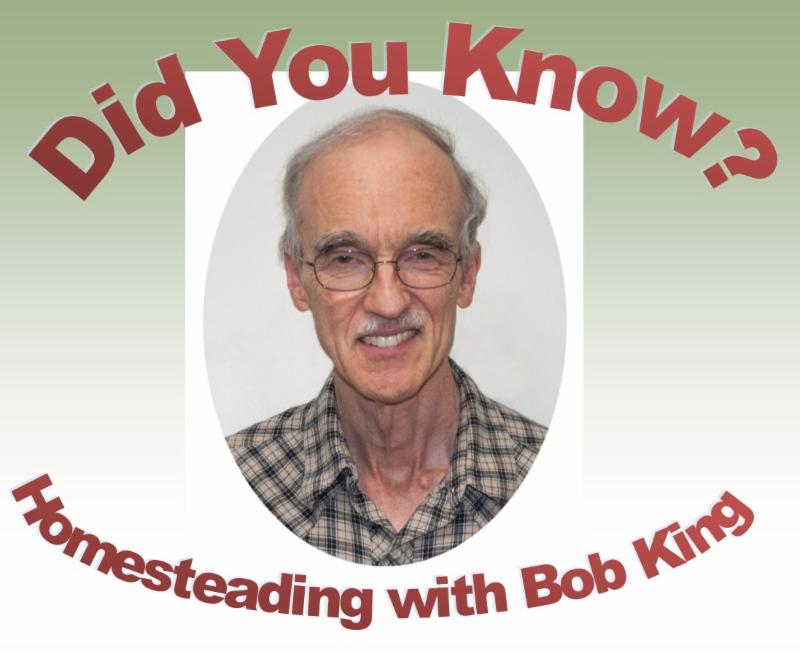
Did You Know?
When the Homestead Act of 1862 was passed, it allowed claims of up to 160 acres of federal land for the purpose of create privately-owned farms. That amount of land was generally enough to support a family in areas with sufficient rainfall, thus allowing for the successful raising of marketable crops like wheat, barley, rye, and corn. But there were also many areas of the West where rain was sparse or unpredictable, and a 160-acre homestead was insufficient for making a sustainable living due to low or undependable crops yields. Consequently, in the early 20th century, some state and territorial legislators to Congress began proposing laws to amend homesteading terms to increase the maximum size of of homesteads to greater than 160 acres. The best known successful example of this occurring was the 1904 "Kinkaid" Homestead Act. On April 6,1904, Moses Kinkaid, a Nebraska Congressman representing much of western and northwestern Nebraska, introduced a bill in Congress to allow for 1,280-acre size homesteads (two square miles of land) in that part of the state. The region is referred to as the Sandhills of Nebraska. It is a largely arid region with light, sandy soils and hilly terrain found in 37 Nebraska counties where even irrigation is largely not possible. After a review of Kinkaid's bill, the Committee on Public Lands in Washington, DC trimmed the size down to 640 acres, which was still four times the size of the usual homestead. Subsequently, the revised law rapidly passed Congress on April 28, 1904. The story of its success as a variation to traditional homesteading is fairly well known, particularly in Nebraska, but like most everything involving homesteading, there was more going on at this time.
First, the 1904 "Kinkaid" Homestead Act, was not the first law to allow for homesteads larger than 160 acres. That distinction goes to Alaska. On March 3, 1903, a law was passed allowing the maximum size of homesteads in Alaska to increase from 80 acres to 320 acres. That was a bit curious as homesteading was only first allowed in Alaska in 1898, and by 1903 very few homestead entries had been made. So, why this change happened in 1903 isn't entirely clear, but it certainly wasn't related to arid conditions in Alaska like found in western and northwestern Nebraska. More likely it was due to the reality that homesteading would be harder to do in Alaska (shorter growing seasons, often poor soils) so offering more land was a way to draw in more settlers and provide more opportunity to succeed.
Apart from Alaska, while Nebraska Congressman Moses Kinkaid was successful in 1904 in accommodating the special land needs of homesteaders in much of the area he represented in Congress, he was not the only Congressman trying to do that. Others in other western states with similar dry land conditions also wanted larger homesteads. On February 10, 1905, the same Committee on Public Lands that was involved evaluating Kinkaid's 1904 bill less than a year earlier, issued a special report. It was on allowing 640-acre homesteads in parts of Colorado as proposed in a bill (H.R. 18787) recently introduced into the House of Representatives. Interesting, the report told that this particular bill was a substitute for several other similar bills introduced earlier, and that it was written to more closely correspond to one also introduced for larger homesteads in North Dakota. While the 1905 report was favorable to the idea, the proposed bill didn't become law, and 640-acre homesteads would only apply to Nebraska for the next few years. But the story didn't end there.
The growing sentiment to increase the size of homesteads in dryer areas led to the passage on February 19, 1909 of the "Enlarged Homestead Act." It initially allowed homestead claims of up to 320 acres in Colorado, Montana, Nevada, Oregon, Utah, Washington, Wyoming, and the territories of Arizona and New Mexico. Later, more states were added by amendments or separate laws. Then on December 29, 1916 a new form of homesteading was passed by Congress allowing for claims up to 640 acres, the same maximum size first allowed in Nebraska in 1904. But the purpose was quite different. The 1916 law, called the "Stock Raising Homestead Act," allowed lands to be homesteaded where their principle use was for grazing and raising forage crops, thus not for raising traditional agricultural farm crops that were at the heart of homesteading when it began with the 1862 Homestead Act. Rather, by 1916, many of the western lands left for homesteading were not suitable for economically raising food crops for market, and so stock-raising was finally allowed to be the basis for getting a homestead--and one up to 640 acres.
In all, in the first two decades of the 20th century, homesteading policies evolved to better fit the unique circumstances of what lands were available for homesteading in the West and Alaska, including how the climate affected the needs of a homesteader. The intriguing story of the changes made to the allowable size and even purpose of some homesteads at this time is a great example of this evolution. It is yet another part of the fascinating history of homesteading in the United States.
|
 |
Heartland Inventory & Monitoring Network
Management of a National Park Service site calls for extensive information and monitoring of a park's natural resources. Parks are groped into regional monitoring networks - Homestead National Monument of America is grouped with the Heartland Inventory and Monitoring Network, which is responsible for an area from Ohio to Kansas, and Arkansas to Minnesota
The park staff who support the Heartland Inventory and Monitoring Network help monitor natural resources at fifteen different parks across the region, including plant, bird, and fish communities, in addition to monitoring for invasive species.
Projects at Homestead have included Bird Monitoring from 2009 to 2017, a Fish Community Status report from 2004 to 2015, and an Aquatic Invertebrate Monitoring report from 1996 to 2011.
The most recent project completed involved monitoring the grasslands and woodlands to remove invasive species, including dogwood and sumac, which threatened to crowd out tallgrass species, which was completed in June of this year.
|
 |
 |
|
|
|
Upcoming Events
|
|
Special Events at Homestead National Monument of America:
April - August : Promontory Point Exhibit (Education Center)
July - September: Smoke Over Oklahoma Exhibit (Education Center)
Saturday, July 13th, 10 a.m.: Kids in Parks: Blast off with Birds!
Saturday, July 13th, 7:00 p.m.: Summer Campfire Program
Saturday, July 20th, 10 a.m. Kids in Parks: Homestead the Future
Saturday, July 20th, 4:00 - 11:00 p.m: 50th Anniversary of Apollo 11 Events
Sunday, July 21st, 2:00 p.m.: Artist-in-Residence Program: Heather Heckel
Sunday, July 21st, 3:00 p.m.: Latino Conservation Week and World Migratory Bird Day
Saturday, July 27th, 10 a.m. Kids in Parks: Carbon Based Lifeforms Detected
Saturday, July 27th, 7:00 p.m.: Summer Campfire Program
|
|
|
 |
 |
Cultural Resources Corner: First Homesteader Painting Restoration

Augusta (Gusta) Strohm was an artist from Ohio who lived for several years in Beatrice in the late nineteenth century. While here, she created an oil painting of the Daniel Freeman Homestead, entitled simply
The First Homestead (1888). This painting was on display at the United States Capitol building for some years after Strohm's rise to popularity following the display of her artwork at the 1892 Columbian Exposition in Chicago. It was returned to Nebraska by Congressman Charles Sloan, and donated to the Nebraska State Historical Society in 1917. In 2011 the painting was transferred to Homestead National Monument of America.

Park museum staff determined the painting needed to be conserved, and recently prepared it to be sent to the Ford Conservation Center in Omaha. Funding for this project was made possible through the sponsorship of the National Society of the Daughters of the American Revolution and the generosity of the Friends of Homestead.
|
Hands-On Art with Artist-in-Residence Heather Heckel
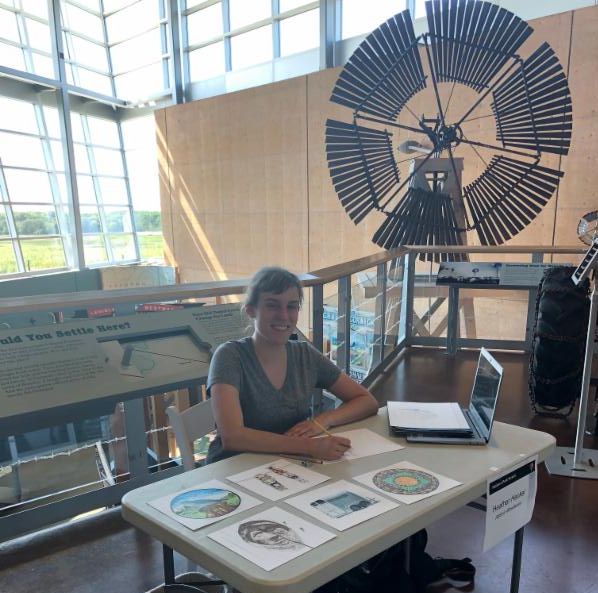
On Sunday, July 21, 2019 at 2 p.m., Homestead National Monument of America Artist-in-Residence Heather Heckel will present an interactive craft class in which participants will create their own designs using radial symmetry. This class is free and open to all ages. All supplies will be provided.
Heather Heckel will be in residence at Homestead National Monument of America from July 16 through July 29. During her stay at the monument, Heckel will work on her paintings out on the grounds of the monument and in the buildings. Visito
rs are welcome to come and visit with her during her residency.
Heckel is currently an art teach at Carrie Palmer Weber Middle School in Port Washington, New York. She has completed Artist-in-Residencies at other National Park Service sites including Indiana Dunes National Park, Herbert Hoover National Historic Site, Whiskeytown National Recreation Area, Lake Roosevelt National Recreation Area, Weir Farm National Historic Site, and Hot Springs National Park.
"We are excited to have such an experienced artist work with us," stated Superintendent Mark Engler. "We hope that our visitors take advantage of her stay here by interacting with Heather."
|
 |
|
Following in the Footseps of Latino Homesteaders:
Latino Heritage Intern: Veronica Barreto Rosa
|
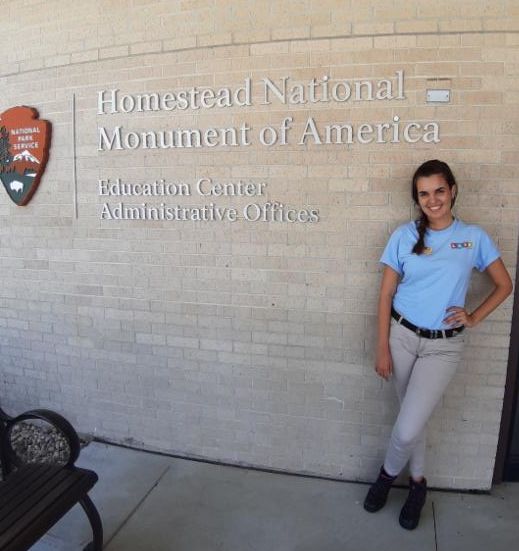
Research on Latino descent homesteader families in the Southwestern states is my main project here at
Homestead National Monument of America, during the summer, as an intern for the Latino Heritage
Internship Program.
Today about 93 million Americans are descendants of homesteaders. We can deduce that one of the
most significant contributions that brought the Act was immigration. To have an idea, the census of the
United States reveals that the total population of states and territories (excluding Texas) west of the
Missouri River doubled from 1860 to 1870 as stated in a study done by the historian Blake Bell. The
Homestead Act was signed in 1862 so the data from the census shows a correlation between these
events.
These people came from many places around the globe and representing different nationalities, some of
them were even Latinos. In the Southwestern states the Latino homesteader's legacy is one of the most
important in the area. For example, in a state like New Mexico, a simple search will let you realize that
about half, if not the majority, of the homesteaders had Hispanic last names. In other states, some of
the counties had been developed because of the Latino homesteaders.
For what I have found so far, the stories of Latino homesteaders are full of challenges, empowerment,
determination, and sacrifices. Even though some of these stories were sad, other, especially those of
Latino single and widow women are very significant since women didn't have many rights by the time.
|
|
The Summer Campfire Program is back!
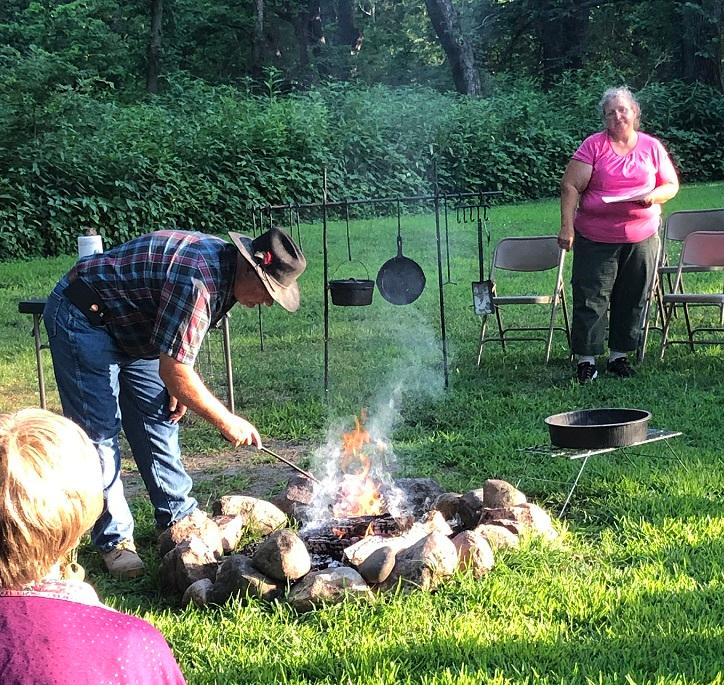
Join us on July 4th and then on Saturday evenings July 13-August 10 at the Homestead Education Center for our summer campfire program series!
Each program will begin at 7 p.m. with a special speaker. Each evening features a different speaker and the topics vary from agricultural history to our nation's foundational documents. After the speaker, there will be a musical performance:
July 4:
-
"Foundation Documents: The Declaration of Independence and the Homestead Act"- Jonathan Fairchild, Homestead National Monument of America Historian
-
Michael Murphy- Musical Performance
July 13:
July 20:
-
Apollo 11 50th Annviersary Program- Timothy Livengood, NASA
-
Native American Star Lore- Ryan Paul
-
Chris Sayre- Musical Performance
-
Hands-On Activities (4 p.m.-7 p.m.)
-
Star Party (9 p.m.-11 p.m.)
July 27:
-
Drone Use in Agriculture- Jackson Stansell and Samantha Teten, University of Nebraska-Lincoln
-
Frailin' Hearts- Musical Performance
August 3:
August 10:
-
The Germans from Russia Homesteading Story- Sara Roberts, American Historical Society of Germans from Russia
-
Windy River Dulcimers- Musical Performance
All programs are free. Some will be held outdoors. Visitors are welcome to bring their own lawn chairs and are encouraged to bring bug spray.
|
|
BATS!
Bat Studies and Programs at the Monument
Bats are Homestead National Monument of America's Favorite Winged Mammals!
June and July are the months that bat pups are born, making it a great time to let you know what is going on with bats here at Homestead National Monument of America!
Homestead is home to around 7 different species of bats.
To help give us a better understanding of the Monument's bat community, the park has entered into a cooperative agreement with the University of Nebraska at Lincoln to further investigate what species are using the Monument and what habitats those bats are using.
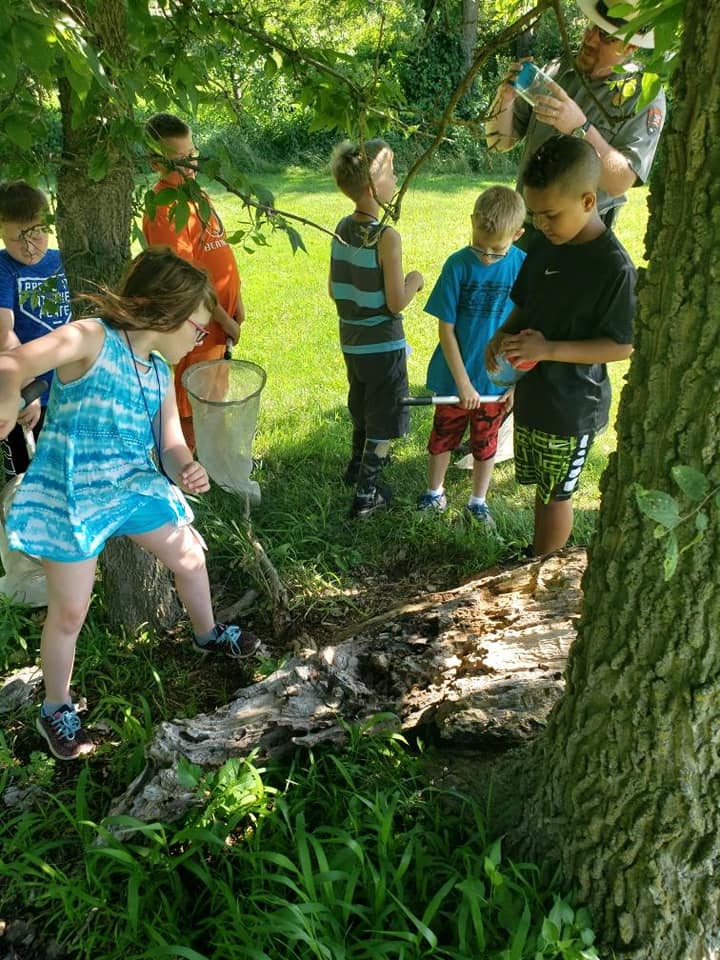
Other bat happenings included the Ranger Jesse Bolli hosting a group of Beatrice Public School summer school students for four days at the end of June for a fun session called "Bats Eat Bugs." The high point of the week was learning the song "Bats Eat Bugs" and constructing bat houses that the students were able to take home with them.
|
 |
 |
You don't have to feel as disconnected as the first homesteaders did.
Stay in touch with us all the time!
|
|
Contact Us
|
|
|
|
Homestead National Monument of America
402-223-3514
|
|
|
|
 |
|
|
|
|
Copyright © 2018. All Rights Reserved.
|
|
|
|